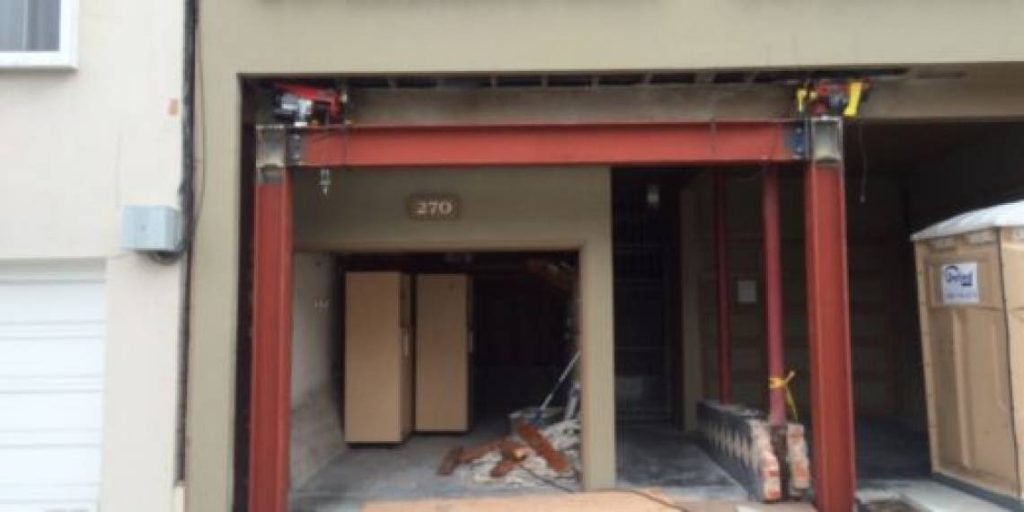After the most recent earthquakes that hit Ridgecrest on July 4th and 5th, soft-story retrofitting has become a popular topic of conversation among property owners in Southern California. By now, all property owners in the greater Los Angeles area should have completed a soft-story retrofit, or begun one. If you haven’t started yours, time is wasting, the deadline for completion is 2022.
When retrofitting your soft-story building you will find three main solutions that are used. Most common is the special moment frame. Special moment frames are used in large or heavy buildings and can be delivered already assembled. This article will compare the benefits of the two pre-eminent manufacturers, Simpson Strong Frame and MiTek USA, of moment frames to help you make the choice that is right for you.
Simpson Strong Frame Benefits:
- Designed for soft story retrofit utilizing the propriety Yield Link, or “structural fuse”.
- Heavily tested. Simpson provides supporting engineering details and notations.
- Supported by an integrated system of hardware, screws, and connectors.
- No welding needed.
- Bolted system that ships flat.
MiTek Moment Frames Benefits:
- Specially designed for Soft story retrofits, utilizing the “Side-Plate System.” AISC 358 Prequalified Moment Connection Standard.
- Standardized sizes that are pre-engineered for easy specification by designer.
- Custom Moment Frame Designs available for residential, commercial and industrial use. Meeting 3rd party agency evaluation for alternative materials is not required.
- System is approved by AISC’s “Connection Approval Review.”
- Lateral bracing of the beam is not required.
- Field welding may be required.
Differences Between the Two
Although the special moment frames look similar, they are not identical. The MiTek Hardy Frame and the Simpson Strong Frame are two distinct systems. Here are the differences between them:
At the top of the column, the connection is different:
- Simpson features a bolt-on method that can be performed by hand. It also has “Yield Link” technology that will absorb the brunt of lateral movement caused during a seismic event. The damaged links can be replaced while the top beam stays in place. This prevents the expense of replacing the beams and columns.
- MiTek uses fixed top connections. If the connection becomes damaged after an earthquake, the beams and columns need to be removed and replaced which can be very expensive.
Shipping and Assembly of SMF’s are different:
The Simpson frame is bolted together on the job site, so it ships flat. While the MiTek is shipped fully assembled. While this cuts down on assembly time on the job, the beam is harder to ship and more difficult to handle.
Similarities Between the Two
Both moment frames look similar and are installed in the same way, but they have other similarities too.
- Both systems were designed for retrofitting soft-story buildings and are a cost effective alternative to traditional field-welded frames.
- Both are pre-engineered and include supporting details, such as load ratings, and notations for use in the engineering plans.
- Both systems eliminate the need for lateral bracing.
- Both provide proven quality control in the connections that can’t be replicated in the field.
- The cost of both systems are comparable.
- Both frame systems are made in California.
Recommendation:
These two special moment frames will work to strengthen your building in the event of an earthquake. But the Simpson SMF System provides more value for the money. The reason for this is based on two factors. One, the Simpson frame system provides continuous use for the beam and the frame. If it becomes damage, it is easily repaired, saving you thousands of dollars in replacement costs. And, two, Simpson’s technical support is far better. They offer a team of experts that will be available to help with the retrofit design and installation process.
Want to Know More?
If you have questions about the LA Soft-Story Retrofit program then check out our blog page. We have numerous articles on the topic to help you understand the new building ordinances and the retrofitting process. Start with our in-depth article, Everything You Need to Know about Your Los Angeles Soft-Story Retrofit on our website. You will also find our other retrofit articles and see some of the projects we have completed. Our team of professional staff have developed this content to help property owners like yourself. If you still have any questions, feel free to give us a call. RetroFitting 360 is here to help answer your questions and relieve the stress of your retrofit project.
About Us
RetroFitting 360, Inc. is a leading provider of soft-story earthquake retrofits in the Los Angeles area. Our experienced staff will focus on the most cost-effective and efficient construction solution to meet your needs. Our civil and structural professionals will draw up the necessary plans to modify the building that are needed for permits to be issued.
Our team is committed to turning your soft-story retrofit into as easy a process as we can for you and your tenants. If you are worried about the stability of your building, or you received a letter from the city to comply with the mandatory Soft-Story Retrofit Program we can help. Contact us today to schedule a free inspection of your property and find out about the cost-effective solutions available to you.
If your building is one that has been mandated to complete a soft-story retrofit by a Los Angeles retrofit contractor, we can get you started. When you set up an initial consultation, one of our professional contractors will do a walkthrough of your property to assess the current conditions. Then they will draw up a detailed step-by-step guide for you of what modifications need to be done so you will be in compliance with the ordinance.


